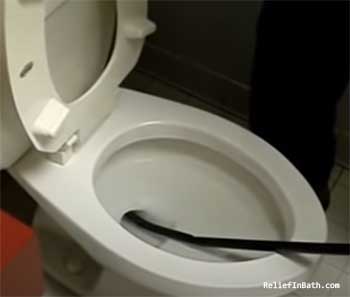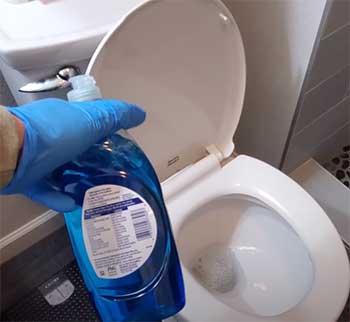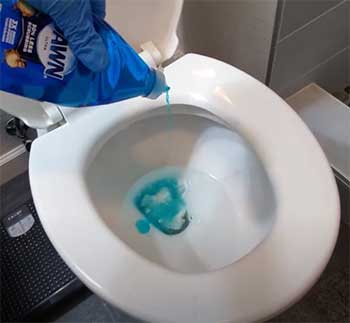Often, you will face an issue with your toilet trap where it gets a lot of calcium buildup. This can be very concerning because it will slow down the toilet’s flushing.
This results in getting water stuck on the toilet bowl, which is something you would not want.
So, if you also have a calcium buildup in the toilet trap, I have just the solution for you. Here, I will go through why this happens and how to fix it properly.
Without wasting any more time, let’s get right into it.
What Causes Calcium Buildup In The First Place?

Well, calcium buildup is pretty natural to happen. Because among different sorts of minerals in the water, calcium is undoubtedly an overpowering one.
It doesn’t damage the plumbing, but it can cause calcium buildup in the pipes or any other places where the water goes through.
Whether it’s the toilet bowl or the toilet trap, you can notice some calcium buildup on them.
There is nothing to worry about with the calcium buildup on a toilet bowl because you can see it in front of you and clean them up.
- Hard Water
The number one cause for calcium builds up is hard water. If you live in a locality with a hard water supply, you will undoubtedly encounter a calcium buildup problem sooner or later.
It can occur in your toilet bowl, toilet trap, and toilet pipes. In short, no plumbing is safe when you are living in an area with hard water.
- Not Being Aware Of The Calcium Buildup
There are some things to be concerned about when it comes to calcium buildup in your toilet trap. The first thing to worry about is the fact that you can’t see the calcium building up in the toilet trap.
As a result, you won’t even know whether there is calcium buildup happening or not until you experience the issues.
- Lack Of Cleaning
Another reason for calcium buildup is the lack of cleaning in your bathroom. You can hardly stop the fact that there will be calcium buildup when there is a hard water supply in your plumbing.
So, you have to make sure you are cleaning the toilet properly and regularly to keep away the calcium buildup.
Well, you can look out for the signs of a calcium buildup in your toilet trap. If you don’t see any calcium buildup in any other places, you must assume that these signs are caused by calcium buildup on the toilet trap.
Usually, there are two signs you will notice for a calcium buildup in the toilet trap. One is slow flushing. This means whenever you flush your toilet, it flushes very slowly and takes a lot of time to clean up.
Another sign is the water getting stuck on the toilet bowl or not clearing up the gunk on the toilet bowl. You can see a bit of calcium buildup on the edge of the toilet trap, but it doesn’t show you the full picture of the issue.
Whatever the case is, if you see these signs, it’s best to opt for a solution to fix the issue the right way. Because the more you wait, the harder calcium buildup gets.
So, let’s get on with the solutions you can try out for calcium buildup in the toilet trap.
Solution For Calcium Buildup In The Toilet Trap
There are several ways you can use to dissolve calcium deposits in your toilet trap. Different ways work better in different scenarios.
Let’s check out some of them and see which one works out for you the best.
- Using Chemicals

The easiest solution you can try out for clearing up the calcium buildup on a slow flushing toilet is through chemicals.
You won’t have to put too much effort or any force to get rid of them. Simply buy the chemical from the store and use it as instructed.
All you have to do is put the chemical into the toilet bowl and let it sit there for a while.
When you are putting the chemicals in, make sure that the bowl’s water level is a bit lower than usual. This helps in increasing the effectiveness of the chemicals.
After letting it sit for a while, you can simply flush the toilet. This way, the chemicals get into the toilet trap and work on the calcium buildup that happens all around it.
Citric Acid
For more stubborn calcium deposits, turn to citric acid cleaners. The crystallized powder form works best for declogging drains. Follow a similar process:
- Pour 1 cup of citric acid crystals into the toilet bowl. Let sit for at least 30 minutes. The longer time allows citric acid to break down minerals.
- Flush repeatedly to wash away dissolved scale.
- Check flushing power. For heavy buildup, repeat as needed until clear.
- Flush with plain water several times when done to remove citric acid residue.
Citric acid dissolves calcium carbonate like vinegar but is stronger for tough limescale. It may take several treatments to fully clear years of accumulation. Wear gloves when handling pure citric acid powder.
Phosphoric Acid Cleaners
Phosphoric acid is the active ingredient in many commercial toilet bowl cleaners. It dissolves mineral deposits like calcium carbonate. Check the ingredient list for phosphoric acid when choosing a calcium-dissolving toilet cleaner.
Follow the product instructions for use. Apply it directly to stained areas in the bowl and let it sit before scrubbing and flushing away dissolved gunk. Phosphoric acid products are relatively fast acting but can be harsh. Use caution on toilet surfaces.
If you choose this method, make sure to get a good quality chemical for clearing up mineral deposits.
Also, make sure to use a mask while doing this because you don’t want to breathe in the chemical fumes as they are quite dangerous.
- Use Vinegar
Well, it’s pretty much the same as using chemicals. You can try out using vinegar to clear up the calcium buildup in your toilet trap. It also helps out a lot in clearing up the buildup in toilet pipes.
Simply put vinegar on the toilet bowl and let it sit for about 30 minutes. The acid in the vinegar helps dissolve the calcium buildups when you flush the toilet.
You can try using a bucket of hot water to loosen up the calcium buildup to clear it out properly.
These are three popular ways to get rid of calcium buildups on your toilet trap. You may need to do these a couple of times to clear up all the buildups.
For the most part, these should be enough. And it’s great to pair them up with hot water, especially when the calcium buildup gets very hard. Hot water helps a lot in loosening the calcium.
However, if none of the solutions works out, then opt for professional plumbing help. It’s better to avoid things like sticks or metal pipes to clear out the calcium buildup from the toilet trap.
These things can sometimes cause damage to your toilet and ruin the whole thing.
Prevent Calcium Buildup In The Toilet

The best suggestion I can give you regarding this whole thing is to use preventive measures for calcium buildup in your toilet.
You can do several things to make sure that the calcium buildup doesn’t happen in the toilet trap too much, and you can easily get rid of it.
Having said that, two things can help you keep your toilet clean overall. Let’s get through them one by one.
- Deep Cleaning Your Toilet
Well, you don’t need to clean your toilet deep every day or every week. You don’t even need to deep clean every month.
Doing it every 6 months is more than enough to keep away any kind of calcium buildup in the toilet.
Now, that doesn’t mean you will only opt for deep cleaning. You must ensure you are going through a normal cleaning process every week to prevent that calcium buildup.
It’s very easy to go through regular cleaning; all you will need is vinegar.
Just put some vinegar in the toilet and let that sit for about 12 hours. This should dissolve any kind of minerals that may be lingering in the toilet. Then, flush your toilet several times to finish the cleaning.
- Using Water Softener
Since calcium buildup mostly happens from hard water, using a water softener can easily fix the whole thing. You can get a water softener system and install it in your toilet.
This is a great solution for mineral deposit buildup in your bathroom without worrying about them too much.
This softener system works because it attracts all the mineral deposits like magnesium and calcium using a negative charge.
Since the minerals tend to have a positive charge, they get easily attracted to the negative charges of the softener. Usually, these softeners have resin beads that carry the negative charge to pull the minerals.
This water softener system directly targets the source, so you won’t even have to worry about hard water entering the toilet plumbing. If there is no hard water in the system, you won’t face calcium buildup or any other mineral buildup at all.
These are great ways to prevent any kind of calcium buildup in your toilet trap. Rather than looking for solutions to the problems, you can always try out these preventive measures.
Even though the water softener can be a bit costly to implement, it’s truly worth it. You won’t have to worry about cleaning your toilet too often. Also, there will be no worries of hard water in the system either.
But if you don’t want to go through that expense, keeping up with regular cleaning sessions and a deep cleaning session every 6 months can help out a lot.
FAQs About Calcium Buildup in Toilet Traps
Acidic solutions work best to dissolve calcium deposits in drains. Mild acids commonly used include:
Vinegar (acetic acid)
Citric acid powder or cleaners
Phosphoric acid found in some commercial toilet cleaners
Sulfamic acid in preventive toilet tablets
These acids react with calcium carbonate, the main component of limescale, to form water-soluble calcium salts that rinse away.
To clean calcium deposits from a toilet trap:
1. Remove the toilet tank lid. Check for visible scale near fittings or blocking drain holes under the flush valve.
2. Pour a calcium-dissolving solution like vinegar into the toilet bowl. Let it react with deposits overnight.
3. Flush repeatedly to rinse away loosened scale through the trap.
4. Check trap function by flushing paper. Full bowl clearance indicates a clear drain.
For severe clogs, you may need a closet auger to physically scrub out stuck deposits after treating with dissolving acids. Avoid harsh drain cleaners.
To remove calcium scale from the entire toilet system:
1. Check for deposits in the tank and bowl. Apply an acidic cleaner like vinegar or citric acid to affected areas.
2. Let it soak in to dissolve minerals. Scrub stubborn buildup with a toilet brush.
3. Flush the toilet over and over to wash away dissolved scale through the pipes.
4. Use drain snakes or augers to physically clear any remaining obstructions.
5. Install bowl tablets or add bleach to tank to prevent future calcium accumulation. Consider adding a water softener for hard water issues.
Yes, calcium deposits can definitely cause flushing problems in toilets. As scale accumulates, it narrows the drain passages, obstructing the normal water flow. The reduced water volume eventually can’t generate enough siphon action to fully clear the bowl. Slow flushes are an early sign of calcium-related issues. Without removal, the drain will eventually clog completely, causing the toilet to not flush at all. Getting rid of calcium buildup is key to restoring full toilet functionality.
Conclusion
All in all, calcium buildup in toilet traps can be a pretty disturbing issue to come across. So, you must treat the issue whenever you come across it.
Leaving it hanging there will make the issue much more severe. It’s better to solve the problem as soon as you can identify it.

I live in a condo built as apartments in the late 60’s, water hardness is a 4 out of 5 – what did you mean install a water softener IN the toilet? I was considering using a Clearwave water conditioner, where you wrap the wires one way around the incoming water pipe, then wrap another set of wires the opposite way , perhaps around the stainless steel plumbing line. These are marginally effective as I read reviews, and from what I have experienced. I just installed a hot water scale water filter from Kleenwater on my hot water incoming line, coming from the condo’s central hot water which supplies two wings, and going to my electric countertop mini-tank water heater. Is it worth the while to install a scale water filter on the water line to the toilet? When my Niagara “tipping bucket technology” toilet started flushing slowly, I taped under the rim as shown on youtube, put CLR in the tank, allowed it to sit overnight, then got a dental mirror and tried to gently pick the crud out of the rim holes with an icepick. I also got a circular wall of scale or something out of the siphon hole that is across from the drain.